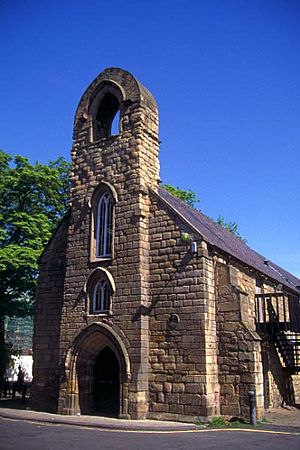Morpeth Chantry facts for kids
The Morpeth Chantry, also known as the All Saints Chantry, is a very old and important building in Morpeth, Northumberland. It stands right next to where an ancient bridge once crossed the River Wansbeck. This building is so special that it's officially recognized as a Grade I listed building, meaning it's of exceptional historical interest.
Contents
What Was the Morpeth Chantry?
The Chantry was built around the year 1296. It had two main jobs back then. First, it was a small church or chapel dedicated to "All Saints." People would go there for prayers and religious services. Second, it also worked as a toll house. This meant that people crossing the river bridge had to pay a small fee, or "toll," there.
The Chaplain's Role
The person in charge of the chapel was called a chaplain. This chaplain had a very important role beyond just religious duties. They were also the schoolmaster for the local children. This shows how important the Chantry was to the community, serving both spiritual and educational needs.
Changes Through History
Over the centuries, the Morpeth Chantry saw many changes. These changes often reflected big events happening across England.
Royal Changes and New Schools
In the 1500s, there were major changes in England's religious life. King Henry VIII closed down many monasteries. Later, his son, King Edward VI, continued this by closing down chantries like the one in Morpeth in 1547. When this happened, the Morpeth Chantry was "deconsecrated." This means it was no longer used as a religious building.
However, the building soon got a new purpose. In 1552, King Edward VI issued a special document called a Royal Charter. This charter allowed a new "free grammar school" to be set up in the Chantry building. A grammar school was a type of school that taught subjects like Latin and Greek. This school eventually became known as King Edward VI School. It stayed in the Chantry building until 1846, when a new school was built somewhere else in Morpeth.
The Chantry Today
After the school moved out, the Chantry building was used for many different businesses. For example, it was once a factory that made mineral water.
Bringing the Chantry Back to Life
By 1974, the building was in poor condition and needed a lot of care. The local government bought the property. They spent several years carefully fixing it up and making it new again. This process is called "restoration" and "refurbishment."
In 1984, the Morpeth Chantry reopened its doors for the community. Today, it's a busy and important place for locals and visitors.
What You Can Find There Now
The Chantry is now home to several interesting places:
- The Northern Poetry Library: A special library dedicated to poetry.
- Northumbria Craft Centre: A place where you can see and buy local crafts.
- Morpeth Chantry Bagpipe Museum: A unique museum dedicated to bagpipes.
- The Tourist Information Office: Where visitors can get help and information about Morpeth.
The Morpeth Chantry continues to be a vital part of the town's history and community life.


